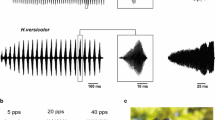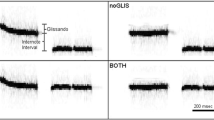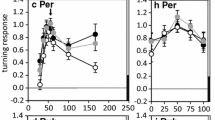Abstract
A behavioural gap detection paradigm was used to determine the temporal resolution for song patterns by female crickets, Gryllus bimaculatus. For stimuli with a modulation depth of 100% the critical gap duration was 6–8 ms. A reduction of the modulation depth of gaps to 50% led either to an increase or a decrease of the critical gap duration. In the latter case, the critical gap duration dropped to 3–4 ms indicating a higher sensitivity of auditory processing. The response curve for variation of pulse period was not limited by temporal resolution. However, the reduced response to stimuli with a high duty cycle, and thus short pause durations, was in accordance with the limits of temporal resolution. The critical duration of masking pulses inserted into pauses was 4–6 ms. An analysis of the songs of males revealed that gaps (5.8 ms) and masking pulses (6.9 ms) were at detectable time scales for the auditory pathway of female crickets. However, most of the observed temporal variation of song patterns was tolerated by females. Critical cues such as pulse period and pulse duty cycle provided little basis for inter-individual selection by females.






Similar content being viewed by others
References
Balakrishnan R, Pollack GS (1997) The role of antennal sensory cues in female responses to courting males in the cricket Teleogryllus oceanicus. J Exp Biol 200:511–522
Benda J, Hennig RM (2008) Spike-frequency adaptation generates intensity invariance in a primary auditory interneuron. J Comput Neurosci 24:113–136
Berger D (2008) The evolution of complex courtship songs in the genus Stenobothrus Fischer, 1853 (Orthoptera, Caelifera, Gomphocerinae). Dissertation, Friedrich-Alexander-Universität Erlangen-Nürnberg, Erlangen
Dent ML, Klump GM, Schwenzfeier C (2002) Temporal modulation transfer functions in the barn owl (Tyto alba). J Comp Physiol A 187:937–943
Elliott CJH (1983) Wing hair plates in crickets: physiological characteristics and connections with stridulatory motor neurones. J Exp Biol 107:21–47
Elliott CJH, Koch UT, Schäffner KH, Huber F (1982) Wing movements during cricket stridulation are affected by mechanosensory input from wing hair plates. Naturwissenschaften 69:288–289
Ferreira M, Ferguson JWH (2002) Geographic variation in the calling song of the field cricket Gryllus bimaculatus (Orthoptera: Gryllidae) and its relevance to mate recognition and mate choice. J Zool Lond 257:163–170
Gleich O, Klump GM (1995) Temporal modulation transfer functions in the European Starling (Sturnus vulgaris) II. Responses of auditory-nerve fibres. Hear Res 82:81–92
Gottsberger B, Mayer F (2007) Behavioral sterility of hybrid males in acoustically communicating grasshoppers (Acrididae, Gomphocerinae). J Comp Physiol A 193:703–714
Heller K-G (2006) Song evolution and speciation in bushcrickets. In: Drosopoulos S, Claridge MF (eds) Insect sounds and communication: physiology, behaviour, ecology and evolution. CRC Press, Boca Raton, pp 137–152
Hennig RM (2009) Walking in Fourier’s space: algorithms for the computation of periodicities in song patterns by the cricket Gryllus bimaculatus. J Comp Physiol A 195:971–987
Hennig RM, Franz A, Stumpner A (2004) Processing of auditory information in insects. Micr Res Techn 63:351–374
Joris PX, Schreiner CE, Rees A (2004) Neural processing of amplitude-modulated sounds. Physiol Rev 84:541–577
Kostarakos K, Hennig RM, Römer H (2009) Two matched filters and the evolution of mating signals in four species of cricket. Front Zool 6:22. doi:10.1186/1742-9994-6-22
Kriegbaum H (1989) Female choice in the grasshopper Chorthippus biguttulus. Naturwissenschaften 76:81–82
Kutsch W, Huber F (1970) Zentrale versus periphere Kontrolle des Gesanges yon Grillen (Gryllus campestris). Z vergl Physiologie 67:140–159
Levine RB, Truman JW (1982) Metamorphosis of the insect nervous system: changes in morphology and synaptic interactions of identified neurons. Nature 299:250–252
Machens CK, Stemmler MB, Prinz P, Krahe R, Ronacher B, Herz AVM (2001) Representation of acoustic communication signals by insect auditory receptor neurons. J Neurosci 21:3215–3227
Marsat G, Pollack GS (2004) Differential temporal coding of rhythmically diverse acoustic signals by a single interneuron. J Neurophysiol 92:939–948
Mayer F, Berger D, Gottsberger B, Schulze W (2010) Non-ecological radiations in acoustically communicating grasshoppers? In: Glaubrecht M (ed) Evolution in action. Springer, Berlin, pp 451–464
Michelsen A (1985) Time resolution in auditory systems. Springer, Heidelberg
Nabatiyan A, Poulet JFA, de Polavieja GG, Hedwig B (2003) Temporal pattern recognition based on instantaneous spike rate coding in a simple auditory system. J Neurophysiol 90:2484–2493
Natter R, Robillard T, Amedegnator C, Couloux A, Cruaud C, Desutter-Grandcolas L (2011) Evolution of acoustic communication in the Gomphocerinae (Orthoptera: Caelifera: Acrididae). Zoologica Scripta 40:479–497
Pflüger HJ (1999) Neuromodulation during motor development and behavior. Curr Opin Neurobiol 9:683–689
Pollack GS (1988) Selective attention in an insect auditory neuron. J Neurosci 8:2635–2639
Poulet JFA, Hedwig B (2005) Auditory orientation in crickets: pattern recognition controls reactive steering. PNAS 102:15665–15669
Prinz P, Ronacher B (2002) Temporal modulation transfer functions in auditory receptor fibres of the locust (Locusta migratoria L.). J Comp Physiol A 188:577–587
Römer H, Lewald J (1992) High-frequency sound transmission in natural habitats: implications for the evolution of insect acoustic communication. Behav Ecol Sociobiol 29:437–444
Ronacher B, Römer H (1985) Spike synchronization of tympanic receptor fibres in a grasshopper (Chorthippus biguttulus L., Acrididae) A possible mechanism for detection of short gaps in model songs. J Comp Physiol A 157:631–642
Ronacher B, Stumpner A (1988) Filtering of behaviourally relevant temporal parameters of a grasshopper’s song by an auditory interneuron. J Comp Physiol A 163:517–523
Sabourin P, Gottlieb H, Pollack GS (2008) Carrier-dependent temporal processing in an auditory interneuron. J Acoust Soc Am 123:2910–2917
Schildberger K (1984) Temporal selectivity of identified auditory neurons in the cricket brain. J Comp Physiol A 155:171–186
Schul J (1998) Song recognition by temporal cues in a group of closely related bushcricket species (genus Tettigonia). J Comp Physiol A 183:401–410
Thorson J, Weber T, Huber F (1982) Auditory behaviour of the cricket. II. Simplicity of Calling-song recognition in Gryllus, and anomalous phonotaxis at abnormal carrier frequencies. J Comp Physiol 146:361–378
Trobe D, Schuster R, Römer H (2011) Fast and reliable decisions for a dynamic song parameter in field crickets. J Comp Physiol A 197:131–135
Truman JW, Riddiford LM (1999) The origins of insect metamorphosis. Nature 401:447–452
Tschuch G (1977) Der Einfluß synthetischer Gesänge auf die Weibchen von Gryllus bimaculatus De Geer (Teil 2). Zool Jb Physiol 81:360–372
Tunstall DN, Pollack GS (2005) Temporal and directional processing by an identified interneuron, ON1, compared in cricket species that sing with different tempos. J Comp Physiol A 191:363–372
von Helversen D, von Helversen O (1994) Forces driving coevolution of song recognition in grasshoppers. In: Schildberger K, Elsner N (eds) Neural basis of behavioural adaptations. Fortschritte der Zoologie, Fischer, pp 253–284
Weber T, Thorson J, Huber F (1981) Auditory behaviour of the cricket. I. Dynamics of compensated walking and discrimination paradigms on the Kramer treadmill. J Comp Physiol 141:215–232
Acknowledgments
We thank Jan Clemens and Bernhard Ronacher for critical reading of the manuscript and Richard Kempter for careful comments on a revised version of the manuscript. We also gratefully acknowledge the skilful assistance by Katja Jaskowiak for the envelope analysis of male songs. The performed experiments comply with the “Principles of animal care”, publication No. 86–23, revised 1985 of the National Institute of Health, and also with the current laws of Germany. Supported by SFB 618 ‘Theoretical Biology’.
Author information
Authors and Affiliations
Corresponding author
Rights and permissions
About this article
Cite this article
Schneider, E., Hennig, R.M. Temporal resolution for calling song signals by female crickets, Gryllus bimaculatus . J Comp Physiol A 198, 181–191 (2012). https://doi.org/10.1007/s00359-011-0698-6
Received:
Revised:
Accepted:
Published:
Issue Date:
DOI: https://doi.org/10.1007/s00359-011-0698-6




